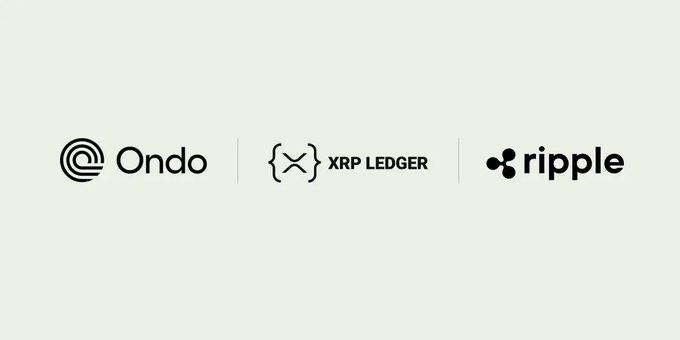OUSG Launches on XRPL: An On-Chain Revolution for Traditional Financial Assets
On June 10, 2025, Ripple officially announced the launch of Ondo Finance’s short-term U.S. Treasury token OUSG on the XRP Ledger (XRPL). As the world’s first tokenized treasury product supporting 24/7 real-time subscriptions and redemptions, OUSG achieves second-level settlement through Ripple’s enterprise-grade stablecoin RLUSD, breaking the T+2 settlement limitation of traditional ETFs. This launch marks a new era of efficient on-chain settlement in the RWA (Real World Asset) space. With $670 million in total value locked, a $1 investment threshold, 5.32% annualized yield, and 0.05% trading slippage, OUSG addresses the core pain points of products like BlackRock’s BUIDL (which has a $50,000 threshold and T+1 settlement).

This market insight article explores OUSG’s zero-coupon mechanism and 24/7 redemption framework on XRPL, and its compliance breakthrough for institutional RWA markets.
Technical Architecture: Around-the-Clock Settlement and Automated Yield
The core innovation of OUSG lies in three technological advancements:
RLUSD Stablecoin Hub
Issued under a MAS (Monetary Authority of Singapore)-approved payment license, RLUSD reserves are held by institutions such as BBVA (Banco Bilbao Vizcaya Argentaria), and it supports the ISO 20022 financial messaging standard. Its value lies in connecting on-chain and off-chain settlement systems: when users subscribe to OUSG, RLUSD is instantly transferred to Anchorage Digital’s trust account, triggering U.S. Treasury allocation under BlackRock’s custody. During redemption, the on-chain burning of the token synchronously releases RLUSD, achieving T+0 settlement.
Zero-Coupon Compounding Mechanism
Treasury interest is automatically accrued into the token’s net asset value (NAV) daily, eliminating the need for manual withdrawals. For example, holding 100 OUSG (NAV = 100) will generate approximately 0.0146 value gain the next day at a 5.32% annualized yield. The NAV is updated every 30 seconds via on-chain oracles (with error rates < 0.01%).
Optimized AMM Pools on XRPL
The OUSG/RLUSD trading pair utilizes a concentrated liquidity algorithm, compressing slippage to 0.05% (vs. 0.3% for equivalent Uniswap V3 trades). Market makers can capture 0.02% fee revenue via dynamic range orders (e.g., 0.999–1.001), while suppressing price deviations. On-chain settlement flows can be tracked using the JuCoin Yield Tracker.
Market Impact: Reshaping the RWA Competitive Landscape
The tokenization of OUSG drives three major changes:
Financial Inclusion Breakthrough
A $1 investment threshold allows retail users to enjoy institutional-level treasury returns, whereas BlackRock’s BUIDL requires a minimum $50,000. During the Fed’s rate-cut cycle, its 5.32% annual yield forms a clear advantage over negative-yielding European bonds (e.g., Germany’s 2-year at -0.15%).
Institutional Settlement Efficiency Boost
With integrations from Fidelity Digital Assets (Europe) and DBS Bank’s DDAX platform, cross-border subscription times are reduced from traditional T+2 to seconds. A test by Japan’s SBI Mizuho Securities showed that a $1B redemption could be completed in 45 seconds (vs. 48 hours traditionally).
RWA Market Share Reshuffle
In its first week of launch, OUSG added $80M in TVL, pushing the Ondo ecosystem’s share of the RWA sector to 38% (vs. BlackRock 45%, Franklin Templeton 17%). If this growth continues, it could surpass $1.5B by Q4 2025, pressuring traditional asset managers to upgrade on-chain services.
Compliance Depth: Regulatory Adaptability Across Jurisdictions
OUSG has constructed a triple-layer compliance moat:
-
Securities Issuance Exemption: Approved under SEC Regulation D, open only to qualified investors (non-U.S. users are exempt from accreditation);
-
Fully Licensed Stablecoin: RLUSD holds an MPI license under Singapore’s Payment Services Act, with reserves subject to monthly third-party audits;
-
Automated Tax Engine: Via Layer 2 protocol, it auto-withholds 30% non-resident capital gains tax (recognized by the U.S. IRS), avoiding cross-border legal conflicts.
User assets are independently custodied by Anchorage Digital (Trust License No. NYDFS-1003), physically segregated from Ondo’s operating accounts.
If daily net outflows exceed 20% of total TVL, a circuit breaker is triggered to halt subscriptions/redemptions, preventing bank-run risk.
User Guide and Risk Warnings
Investor Pathway:
Subscription:
- Deposit RLUSD via XRPL-supported wallets (e.g., Xumm);
- Swap for OUSG in the AMM pool (minimum $1), with NAV updating in real-time.
Earning Yield:
- During holding, automatic daily compounding with no user action needed;
- Pay 0.15% redemption fee (vs. 0.5% for BlackRock’s BUIDL).
Key Risk Warnings:
-
Interest Rate Volatility: If the Fed cuts rates to 3.5%, OUSG’s yield drops to 3.8%, weakening its advantage vs. crypto staking (e.g., Ethereum at 5.2%);
-
Regulatory Arbitrage Gaps: Under EU MiCA, it may be classified as an “unregistered UCITS fund,” requiring a new license to access the eurozone;
-
Liquidity Dependency: XRPL TVL is only $310M; if market makers exit en masse, slippage may widen to 1%.
Future Evolution of the RWA Track
OUSG’s success depends on three validation metrics: XRPL on-chain daily volume exceeding $5M (current test peak: $2.1M), RLUSD circulation surpassing $200M (current: $110M), and integration with at least three EU-licensed institutions by Q3 2025.
If achieved, it could accelerate traditional asset managers’ shift on-chain (BlackRock’s BUIDL V2 to support real-time redemption on Polygon), and drive DeFi protocols to enter RWA issuance (MakerDAO plans to launch MKRBOND). Otherwise, if on-chain volumes remain weak, competitors like Stellar may seize market share with lower gas fees.





